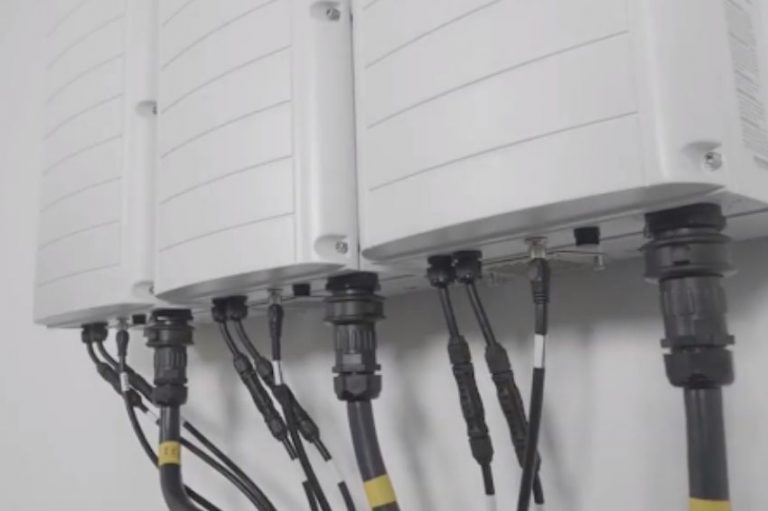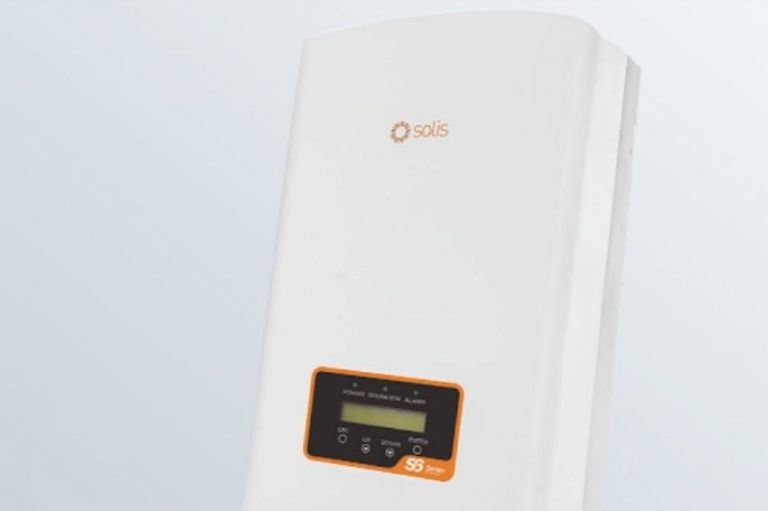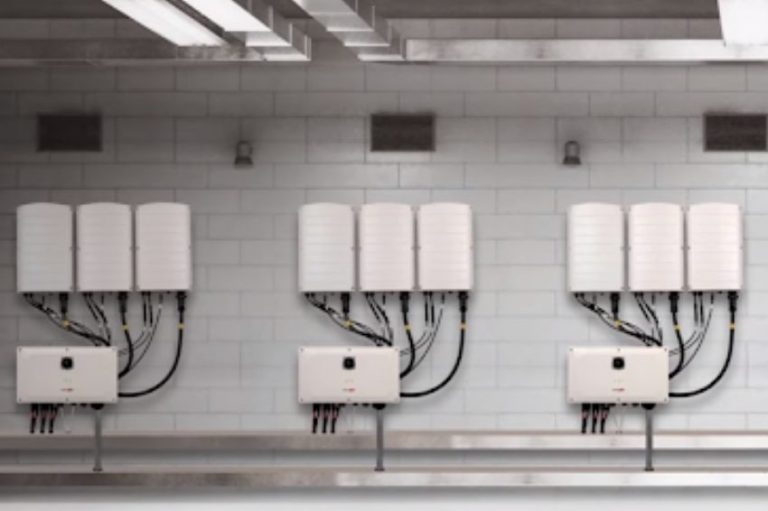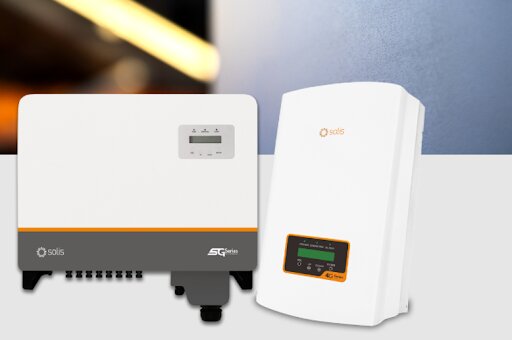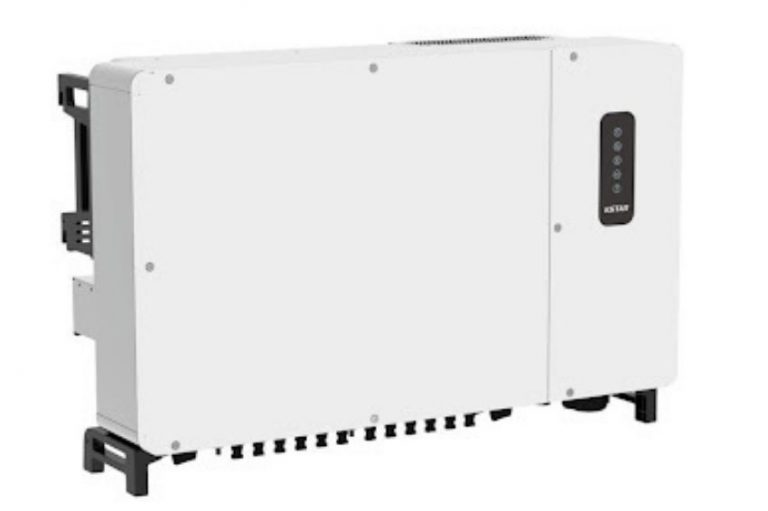The new line of Tauro inverters from Fronius has a design of modularity and adaptation according to the different needs of each installation, being applicable to different conceptions and project topologies.
At this first moment, the inverters launched in Brazil are the Tauro Eco Inverters, in versions D (direct) and P (pre-combined), in the power classes of 50 kW and 100 kW.
The D and P versions of the Tauro inverter are related to the installation topologies that can be implemented, mainly differentiating the types of DC connection of the inverter.
We know that each type of topology used in a photovoltaic installation can generate direct savings in the so-called BOS (Balance of Systems) cost, which will be explored later, therefore the choice of inverter model is crucial to guarantee an economically attractive project.
The entire Tauro Eco line (version D or P) has 1 MPPT input. The word Eco comes from economical, that is, it is an inverter dedicated to commercial and industrial projects (known as C & I), where we find situations of little variation in the orientation of the modules, whether for a ground or even a roof project. Therefore, with 1 MPPT we were able to obtain greater cost savings on the product.
As is customary, the Fronius Tauro inverter also features all the technologies used in the other Fronius inverter lines, which guarantee greater electrical energy generation capacity and higher yields, such as:
- Oversizing of 50% over the rated power of the inverter;
- Dynamic Peak Manager, which guarantees greater generation even in situations where there is partial shading of the modules
- Active ventilation, allowing the inverter to be installed in places with extreme heat situations, always keeping it cool.
Read more: Dynamic peak manager: solution for PV systems with shading
Regarding active ventilation, this is treated as a maintenance-free refrigeration system, that is, it does not require periodic maintenance. In addition to active cooling, the Fronius Tauro features double-wall insulation technology.
This combination allows the internal temperature of electronic components to be maintained at levels well below ambient temperature. Due to this innovative cooling system, the Fronius Tauro can offer maximum performance at an ambient temperature of up to 50°C. This, in turn, has a positive effect on the overall performance of the PV system, as well as the service life of the equipment's power electronics.
Thanks to this exclusive cooling system, the Fronius Tauro can also be installed outdoors without the need for a special shelter. This also means that there is no need for investment in civil works.

This active cooling system offers a particular advantage regarding OPEX (solar plant operation) costs as, unlike other cooling systems, there are no prescribed maintenance intervals that require the attention of specific experts.
Read more: Active ventilation of photovoltaic inverters
Versions
As stated, the Fronius Tauro inverter has two versions: D (direct) and P (Pre-combined). In version D, the DC connection of the inverter is direct, that is, the strings are connected to the inverter directly through the use of MC4 connectors.
As the image below illustrates, in this case the inverters are close to the modules, in a project design called decentralized. It is worth remembering that each individual input has protection by fuses already incorporated, both in the 50 kW and 100 kW classes.
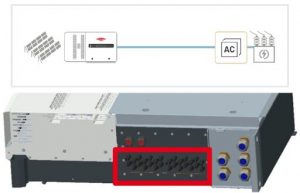
Regarding the number of connectable inputs, the 50 kW inverter has 14 inputs, while the 100 kW version has 22. These inputs are also separated into sets with their respective disconnecting switches, found on the front of the inverter.
For the Tauro 50 kW, the inverter has 2 disconnecting switches, each responsible for disconnecting 7 strings. For the 100kW model, the inverter has an additional switch, totaling 3 disconnecting switches, which is responsible for the remaining 8 strings, totaling 22 inputs.
In version P, the DC connection of the inverter is not made directly. In this version, the use of a string box is necessary, as there are only 2 DC inputs on the inverter.
As the image below illustrates, the inverters, in this case, are located far from the modules and close to the transformer and protection panels, in a project design called centralized. Regarding the protection of the arrangement, this will be the responsibility of the string box itself, sized by the designer.
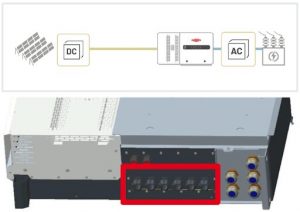
At the bottom of the inverter you can see 6 holes for cable entries (as in the figure above), but only 4 of them (2 entries) will be used (two pairs on the right, identified as PV1 and PV2).
As, for this version, we have two inputs, this is also replicated in the number of disconnector switches, which are also two, for both the 50 kW and 100 kW versions.
Topologies
In terms of photovoltaic plant topology, the model in version D (direct) applies to what we call decentralized topology, where we have the inverters close to the photovoltaic modules and the AC cables with greater distances in the installation, as illustrated below.
The model in version P (pre-combined) applies to what we call a centralized topology, where we have the inverters gathered on a skid, or a room of inverters close to the plant's input pattern, where the transformer is located.
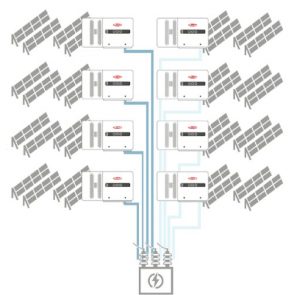

Savings
Depending on individual system requirements, the designer can decide whether a decentralized or centralized system topology is more advantageous for the project as a whole. As Fronius Tauro allows this flexibility, there is great potential to reduce BOS costs.
Depending on the conditions provided, there are different potential savings, each of which represents one of the two inverter versions.
A decisive factor that influences the choice of system topology is the distance between the photovoltaic modules and the main distribution board, directly influencing the cost portion related to cables and string boxes, inserted in the BOS slice.
When analyzing the CAPEX portions of photovoltaic projects, we can see that the costs linked to inverters are not the highest, as shown in Fig.1. However, the selection of this equipment directly influences BOS (Balance of System) costs, which incorporate all costs related to cabling, connections, structures, etc.
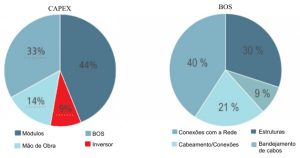
In addition to the distances between modules and frames, which directly influence BOS costs, we currently have another variable, which is the price of cables, which are directly linked to the metal used.
Copper values are traded on the LME (London Metal Exchange) and prices have constantly increased, as we can see in the figure below. For this reason, the use of aluminum cables has become much more attractive and much more economical. Therefore, choosing equipment that allows the use of this type of cable is essential.
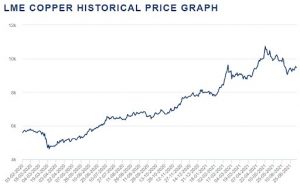
The Tauro inverter, in both connections (AC and DC), has the possibility of connecting with aluminum cables, thanks to the bimetallic connectors used in its construction. Additionally, the cable glands on the AC side can accommodate cables up to 240 mm². For the DC side of the P version, they can receive cables of up to 95 mm², allowing installations over long distances.
Specifically regarding economic sizing, we can see the influence of the section and type of cable used on the savings related to cable losses. Assuming a 2 MW project, with an average distance of 125 m (between modules and switchboard), during 20 years of operation, we have the following loss values:
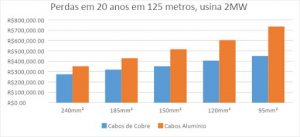
Inevitably, losses in aluminum cables will be greater than in copper cables, due to the greater ohmic resistance in this type of conductor. For this reason, a specific current capacity table for aluminum conductors must be used, in accordance with the NBR 5410 standard.
This information, in reality, points to the possibility of savings in using larger sections, for savings in operation, regardless of the metal used in the conductor. However, in case of losses during plant operation, we specifically talk about OPEX. The highest cable costs are included in CAPEX, as we saw previously.
We can see the advantages of this type of conductor and topology to be used when we plot the graph comparing these variables, in relation to the distances between modules and the main board.
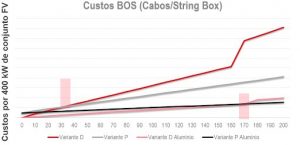
By analyzing the graph presented above, we can identify which configurations are most economically advantageous, in terms of the cost of cables and string boxes. Generally, the centralized installation topology is the most economical for large distances, for copper cables over 40 meters apart, and for aluminum over 170 meters, between modules and the main panel.
Furthermore, we highlight the great difference between the types of metals used in cables (suitably sized according to current capacity and voltage drop). Copper cables, in this scenario, can reach four times the price of the equivalent aluminum cable for the same project.
Obviously, there are restrictions that may prevent the use of one type of topology or another, whether due to physical or even regulatory restrictions on the part of the customers themselves, which is not uncommon to find in industrial sectors. The differences presented were based only on a portion of the BOS costs and prices referenced to a cable and string box manufacturer, as well as analyzed for a specific situation for the study.
These differences do not reflect the total differences when analyzing the project encompassing all costs (CAPEX). However, this study brings to reality the importance of selecting photovoltaic inverters, as well as their installation topology.
The purpose of this article is to present the different possibilities for using the Fronius Tauro inverter and allow the designer to decide on a type of installation that can adapt to the customer's expectations and also the project budget.


